16 13 6 0 10 16 Champion Balti Colts | 0 6 0 10 DAL 3 Date 17 January 1971 | |
Similar | ||
Super bowl v baltimore 16 dallas 13
Super Bowl V, the fifth edition of the Super Bowl and first modern-era National Football League (NFL) championship game, was an American football game between the American Football Conference (AFC) champion Baltimore Colts and the National Football Conference (NFC) champion Dallas Cowboys to decide the NFL champion for the 1970 season. The Colts defeated the Cowboys by the score of 16–13. The game was played on January 17, 1971, at the Orange Bowl in Miami, Florida, the first Super Bowl game played on artificial turf, on first-generation Poly-Turf.
Contents
- Super bowl v baltimore 16 dallas 13
- Super bowl v jim o brien s game winning fg
- Background
- Baltimore Colts
- Dallas Cowboys
- Playoffs
- Super Bowl pregame news and notes
- Television and entertainment
- Game summary
- Final statistics
- Individual leaders
- Records Set
- Starting lineups
- Officials
- References
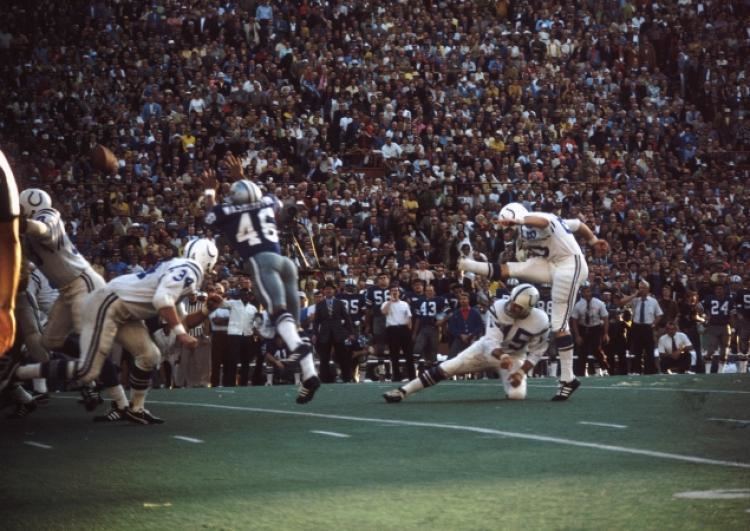
This was the first Super Bowl played after the completion of the AFL–NFL merger. Beginning with this game and continuing to the present day, the Super Bowl has served as the NFL's league championship game, with the winner of the AFC Championship Game and the winner of the NFC Championship Game facing off in the culmination of the NFL playoffs. As per the merger agreement, all 26 AFL and NFL teams were divided into two conferences with 13 teams in each of them. Along with the Colts, the Cleveland Browns and the Pittsburgh Steelers agreed to join the 10 AFL teams to form the AFC. The remaining 13 NFL teams formed the NFC. This explains why the Colts represented the NFL in Super Bowl III, but the AFC for Super Bowl V. Baltimore advanced to Super Bowl V after posting an 11–2–1 regular season record. Meanwhile, the Cowboys were making their first Super Bowl appearance after posting a 10–4 regular season record.
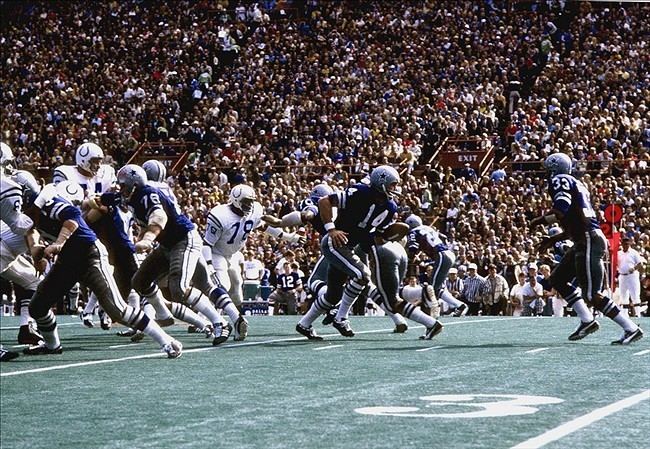
The game is sometimes called the "Blunder Bowl" or the "Stupor Bowl" because it was filled with poor play, a missed PAT, penalties, turnovers, and officiating miscues. The two teams committed a Super Bowl record 11 combined turnovers in the game, and the Colts' seven turnovers are currently the most ever committed by a winning team in a Super Bowl. Dallas also set a Super Bowl record with 10 penalties, costing them 133 yards. It was finally settled with nine seconds left when Colts rookie kicker Jim O'Brien kicked a 32-yard field goal with 5 seconds left in the game. In order to win the game, Baltimore had to overcome a 13–6 deficit after three quarters, and losing their starting quarterback Johnny Unitas in the second quarter.
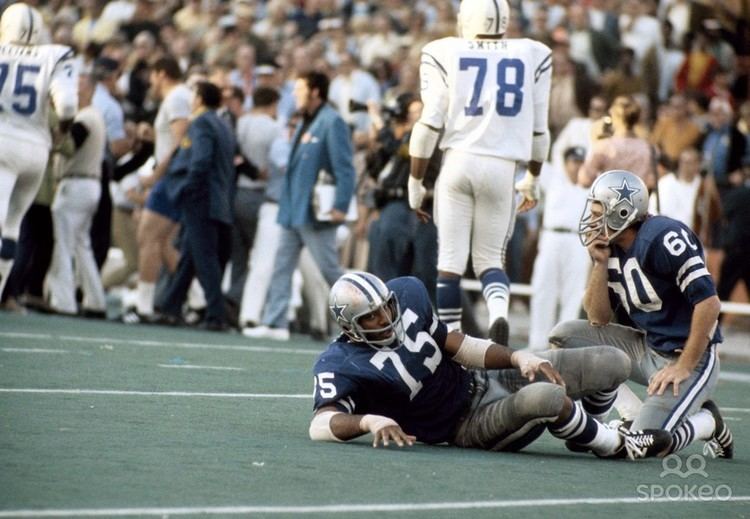
It is the only Super Bowl in which the Most Valuable Player Award was given to a member of the losing team: Cowboys' linebacker Chuck Howley, who intercepted two passes (sacks and tackles were not yet recorded). Howley was the first non-quarterback to win the MVP award. Along this theme, Colts defensive end Bubba Smith would later refuse to wear his Super Bowl V ring because of the "sloppy" play.
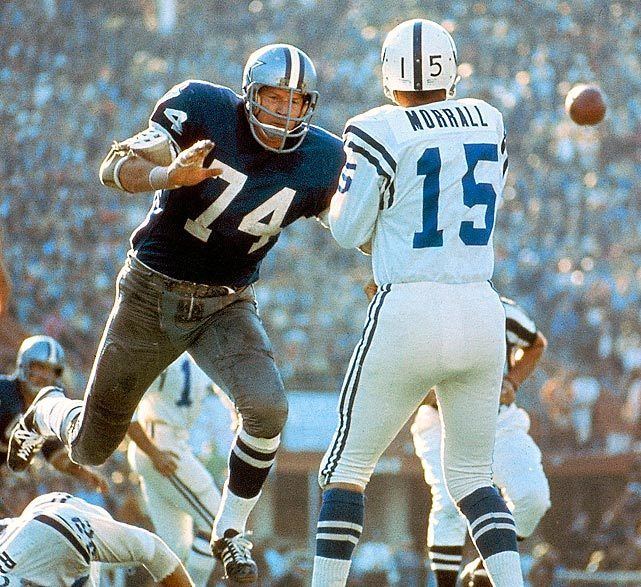
Super bowl v jim o brien s game winning fg
Background
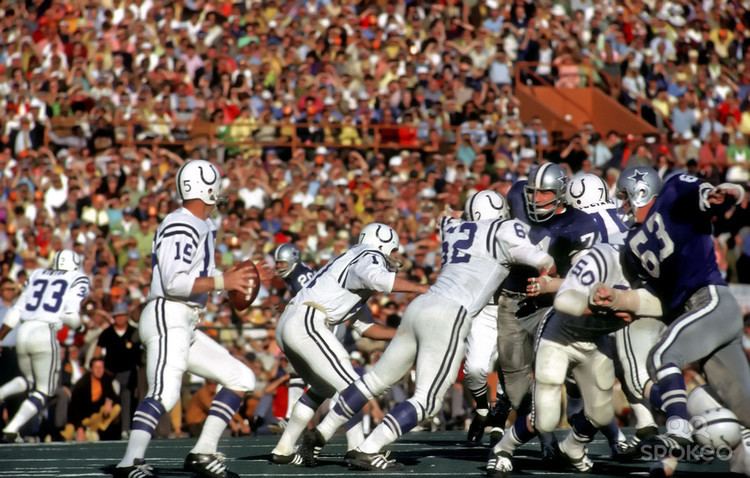
The NFL awarded hosting rights for Super Bowl V to the city of Miami on March 17, 1970, at the owners' meeting held in Honolulu.
Baltimore Colts

The Colts were an unspectacular but well-balanced veteran team, led by 37-year-old quarterback Johnny Unitas. Unitas had regained his starting spot on the team in 1969 upon recovering from an injury that led him to miss the majority of the 1968 season. Unitas played inconsistently during the 1970 regular season; he threw for 2,213 yards, but recorded more interceptions than touchdowns. Unitas also had injury problems, causing him to miss two regular season games and thus giving Earl Morrall more significant playing time. Morrall put up better statistics than Unitas (792 yards, 9 touchdowns, 4 interceptions, and a 97.6 passer rating), but head coach Don McCafferty decided to start Unitas for the playoffs. (According to Jim O'Brien, Morrall was just as good as Unitas in the players' opinion.)
In addition, Baltimore had three solid weapons in the passing game: wide receivers Eddie Hinton and Roy Jefferson, and future Hall of Fame tight end John Mackey combined for 119 receptions, 1,917 yards, and 15 touchdowns. In the backfield, running back Norm Bulaich was the team's top rusher with 426 yards and 3 touchdowns, while also catching 11 passes for another 123 yards.
The Colts' main strength was their defense. Pro Bowl defensive tackle Bubba Smith anchored the line. Behind him, the Colts had two outstanding linebackers: Pro Bowler Mike Curtis, who recorded 5 interceptions, and Ted Hendricks. In the secondary, Pro Bowl safety Jerry Logan recorded 6 interceptions for 92 return yards and 2 touchdowns, while safety Rick Volk had 4 interceptions for 61 return yards.
Don Klosterman, formerly with San Diego, Kansas City and Houston in the AFL, became the Colts' General Manager in 1970. Future Colts GM Ernie Accorsi was the public relations director.
Baltimore finished the regular season winning the AFC East with an 11–2–1 record, also the best record in the AFC. Only the Minnesota Vikings had a better record among all NFL teams, going 12-2.
Dallas Cowboys
The Cowboys had to overcome many obstacles during the regular season. Running back Calvin Hill, the team's second leading rusher with 577 yards and 4 touchdowns, was lost for the year after suffering a leg injury late in the regular season. And wide receiver Bob Hayes was benched by head coach Tom Landry for poor performances on several occasions.
Most significantly, the Cowboys had a quarterback controversy between Craig Morton and Roger Staubach. Morton and Staubach alternated as the starting quarterback during the regular season. Landry eventually settled on Morton for most of the second half of the season, because he felt less confident that Staubach would follow his game plan (Landry called all of Morton's plays). Also, Morton had done extremely well in the regular season, throwing for 1,819 yards and 15 touchdowns, with only 7 interceptions, earning him a passer rating of 89.8. In contrast, Staubach, although a noted scrambler and able to salvage broken plays effectively, threw for 542 yards, and only 2 touchdowns compared to 8 interceptions, giving him a 42.9 rating.
Hayes was the main deep threat on the team, catching 34 passes for 889 yards (a 26.1 yards per catch average) and 10 touchdowns, while also rushing 4 times for 34 yards and another touchdown, and adding another 116 yards returning punts. On the other side of the field, wide receiver Lance Rentzel (who would be deactivated for the last few weeks of the season and postseason following an indecent exposure charge; being replaced in the starting lineup by Reggie Rucker) recorded 28 receptions for 556 yards and 5 touchdowns.
However, the main strength on the Cowboys offense was their running game. Rookie running back Duane Thomas rushed 151 times for 803 yards (a 5.1 yards per carry average) and 5 touchdowns, while adding another 416 yards returning kickoffs. Fullback Walt Garrison, who replaced the injured Hill, provided Thomas with excellent blocking and rushed for 507 yards and 3 touchdowns himself. Garrison was also a good receiver out of the backfield, catching 21 passes for 205 yards and 2 touchdowns. Up front, Pro Bowl guard John Niland and Rayfield Wright anchored the offensive line.
Like the Colts, the Cowboys' main strength was their defense. Nicknamed the "Doomsday Defense", they allowed just one touchdown in their last six games prior to the Super Bowl. Their line was anchored by future Hall of Fame defensive tackle Bob Lilly. Behind him, linebackers Lee Roy Jordan, Dave Edwards and Chuck Howley excelled at stopping the run and pass coverage. The Cowboys also had an outstanding secondary, led by Mel Renfro and Herb Adderley, who combined for 7 interceptions. Safety Charlie Waters led the team with 5 interceptions, while safety Cliff Harris recorded 2.
Dallas finished the regular season winning the NFC East with a 10–4 record, winning their final five regular season games to overcome the St. Louis Cardinals (who lost their final three games and fell to third place in the final standings) and New York Giants (who lost their finale 31–3 to the Los Angeles Rams; a Giants victory would have given New York the NFC East title based upon a better division record and forced a coin toss between the Cowboys and Detroit Lions for the wild card playoff spot).
Playoffs
In the playoffs, Dallas defeated the Detroit Lions in sunny weather at the Cotton Bowl, 5–0, with a field goal and a safety. Then the Cowboys overcame the San Francisco 49ers in the NFC championship game, 17–10, aided by Thomas' 143 rushing yards, along with interceptions by Renfro and Jordan late in the third quarter that were both converted into touchdowns.
Meanwhile, the Colts advanced to the Super Bowl by beating the Cincinnati Bengals, 17–0, and the Oakland Raiders, 27–17, in the playoffs at Memorial Stadium.
Super Bowl pregame news and notes
For the Colts, Super Bowl V represented a chance to redeem themselves for their humiliating loss to the New York Jets in Super Bowl III. Volk commented, "Going to the game a second time took away some of the awe. I think we were able to focus better. There was no way we were going to let ourselves get beat again."
Meanwhile, the game was a chance for the Cowboys to lose their nickname of "next year's champions" and their reputation of "not being able to win the big games". In the past 5 seasons, Dallas had won more games, 52 out of 68, than any other professional football team, but they had never won any league title. The Cowboys had chances to go to the first two Super Bowls, but narrowly lost to the Green Bay Packers in both the 1966 and 1967 NFL Championship games. In the 1966 title game, the Cowboys failed to score a potential tying touchdown on four attempts starting from the Packers two-yard line on the game's final drive. Then in the 1967 title game (the "Ice Bowl"), the Cowboys lost because they allowed the Packers to score a touchdown with 16 seconds left in the game.
As the designated home team, Dallas was forced to wear its blue jerseys for the Super Bowl under rules in place at the time, which did not allow the home team its choice of jersey color, unlike the regular season and playoff games leading up to the Super Bowl. Dallas had not worn its blue jerseys at home since 1963, as Cowboys general manager Tex Schramm opted to have the team wear white at home in order to present fans with a consistent look. The Cowboys wore their blue jerseys twice during the 1970 season, losing 20–7 at St. Louis in week four and winning 6–2 at Cleveland in week 13. The designated home team was first allowed its choice of jersey color for Super Bowl XIII, allowing the Cowboys to wear white vs. the Pittsburgh Steelers.
Vice President Spiro Agnew, a Colts fan since the team began playing in Baltimore in 1953, attended the game [4]. Agnew was Governor of Maryland prior to his election as Vice President as Richard Nixon's running mate in 1968. Nixon himself was a huge football fan and had a vacation home in Key Biscayne, approximately 10 miles from the Orange Bowl.
Television and entertainment
The game was broadcast in the United States by NBC with play-by-play announcer Curt Gowdy and color commentator Kyle Rote. Although the Orange Bowl was sold out for the event, unconditional blackout rules in the NFL prohibited the live telecast from being shown in the Miami area. The blackout was challenged in Miami-Dade District Court by attorney Ellis Rubin, and although the judge denied Rubin's request since he felt he did not have the power to overrule the NFL, he agreed with Rubin's argument that the blackout rule was unnecessary for the Super Bowl. The game was also the first Super Bowl to be carried live in the state of Alaska; thanks to NBC's then-parent company RCA acquiring the Alaska Communications System from the United States Air Force.
The complete original broadcast, up until Chuck Howley's 2nd interception, the first play of the fourth quarter exists, however the rest of the fourth quarter is missing from network vaults. Broadcast excerpts of the crucial fourth-quarter plays, recovered from the Canadian feed of NBC's original, do exist and circulate among collectors. (Two different NFL Films game compilations also cover the fourth quarter plays, in part.)
The bands from Southern University and Southeast Missouri State College performed before the game, while trumpeter Tommy Loy played the national anthem. Loy also played the anthem before every Cowboys' home game from the mid-1960s until the late-1980s. The Southeast Missouri State Golden Eagle Band was featured during the halftime show along with singer Anita Bryant.
Game summary
The first three possessions of the game ended quietly with each team punting after a three-and-out. Then, on the first play of the Colts second drive, Cowboys linebacker Chuck Howley intercepted a pass from Johnny Unitas and returned it to the Colts 46-yard line, the first of 11 turnovers committed by both teams. The Cowboys failed to take advantage of the turnover and punted several plays later. However, Colts punt returner Ron Gardin muffed the return, and the loose ball was recovered by Cowboys safety Cliff Harris at the Colts 9-yard line. The Cowboys were unable to score a touchdown and settled for kicker Mike Clark's 14-yard field goal to establish a 3–0 lead.
After another Colts punt, Cowboys quarterback Craig Morton completed a 47-yard pass to Bob Hayes to reach the Colts 12-yard line, with a roughing the passer penalty adding 6 yards (half the distance to the goal), but Dallas was denied the end zone by the Baltimore defense for a second time. Linebacker Ted Hendricks deflected Morton's pass on first down, running back Duane Thomas was tackled for a 1-yard loss on second down, and Morton committed a 15-yard intentional grounding penalty on third down, pushing the Cowboys back to the 22-yard line and forcing them to settle for Clark's 30-yard field goal, stretching the score to 6-0.
On their next possession the Colts offense got a break. After two straight incompletions to open the drive, Unitas uncorked a pass to Eddie Hinton that was both high and behind the receiver. The ball ricocheted off Hinton's hands, was tipped by Dallas defensive back Mel Renfro, then landed in the arms of tight end John Mackey, who sprinted 75 yards for a touchdown. The Cowboys subsequently blocked Jim O'Brien's extra point attempt to keep the score tied at 6-6, with O'Brien later saying that he was "awfully nervous" and hesitated a second too long before kicking it.
Early in the second quarter, Cowboys linebacker Lee Roy Jordan tackled Unitas, causing him to fumble. Dallas recovered the loose ball and capitalized several plays later, scoring on a 7-yard touchdown pass from Morton to Thomas to establish a 13-6 lead. The next time the Colts had the ball they quickly turned it over yet again, with Unitas unleashing a fluttering interception to Renfro while being hit fiercely on a pass. Unitas was knocked out of the game permanently on the play with a rib injury and was replaced by Earl Morrall, who was widely blamed for the Colts loss in Super Bowl III. The Cowboys were unable to score any points off the turnover, though, and punted. After regaining possession, the Colts offense stormed all the way to the Cowboys 2-yard line with less than two minutes remaining in the half. However, the Cowboys defense stiffened. Colts running back Norm Bulaich was stuffed on three consecutive rushing attempts from inside the 2-yard line. On fourth down, Morrall threw an incomplete pass, turning the ball over on downs and ending the half with Dallas leading 13-6.
The second half was a parade of turnovers, sloppy play, penalties, and missed opportunities.
Colts returner Jim Duncan fumbled the opening kickoff of the second half and Dallas recovered. Then the Cowboys drove to the Colts' 1-yard line, but Mike Curtis punched the ball loose from Cowboys running back Duane Thomas before crossing the end zone, and the Colts took over on a touchback as Duncan was credited with the recovery–-a controversial call because when the resulting pile-up was sorted out, Dallas center Dave Manders was holding the ball. The energized Colts then drove to the Cowboys' 44-yard line but came up empty when O'Brien's 52-yard field goal attempt fell short of the goal posts. However, instead of attempting to return the missed field goal, the Cowboys allowed it to bounce inside their own 1-yard line where it was downed by center Tom Goode (NFL rules prior to 1974 allowed a field goal that fell short of the goal posts to be downed just like a punt; that rule is still in effect in high school football). "I thought it would carry into the end zone", Renfro explained after the game.
Dallas, backed up to its own end zone, punted after three plays. The Colts would have received the ball inside Dallas territory following the punt, but a 15-yard clipping penalty pushed the Colts back to their own 39 to begin the drive. Two plays later, Morrall completed a 45-yard pass to running back Tom Nowatzke to reach the Cowboys 15-yard line. But three plays later, on the first play of the fourth quarter, Morrall threw an interception to Howley in the end zone to preserve the Cowboys' 13-6 lead.
After forcing the Cowboys to punt, the Colts regained the ball on their own 18-yard line, still trailing 13-6. Aided by a pass interference call and a 23-yard completion, the Colts advanced into Dallas territory. The Colts then attempted to fool the Cowboys with a flea-flicker play, resulting one of the oddest plays in Super Bowl history. Running back Sam Havrilak took a handoff and ran right, intending to lateral the ball back to Morrall, but Dallas lineman Jethro Pugh stormed into the backfield and prevented him from doing so. Havrilak then threw a pass intended for Mackey, but it was caught instead by Hinton, who promptly took off for the end zone. However, as Hinton raced toward a touchdown, Cowboys defensive back Cornell Green stripped him from behind at the 11-yard line. The loose ball bounced wildly in the field of play but somehow evaded recovery. It was eventually pushed 20 yards through the back of the end zone for a touchback, thus returning the ball to the Cowboys at their 20-yard line.
Three plays after the turnover the Cowboys returned the favor. Morton threw a pass that was intercepted by Colts safety Rick Volk, who returned the ball 30 yards to the Cowboys' 3-yard line (Morrall later referred to play as the play of the game). Two plays later, the Colts scored on a 2-yard touchdown run by Nowatzke. O'Brien's extra point sailed through the uprights to tie the game at 13–13. (O'Brien says he was much calmer and more confident on this extra point than on the first one, which was blocked.)
The next several possessions ended in traded punts, with the Cowboys eventually taking over in excellent field position at the Colts 48-yard line with less than 2 minutes left in the game.
On the second play of this potential game-winning drive, Dallas committed a 15-yard holding penalty on the 42-yard line, which was a spot foul, pushing the team all the way back to its own 27-yard line (the NFL did not reduce the penalty for offensive holding to 10 yards until 1974). Then, on second down and 35, Morton threw a pass that slipped through the hands of running back Dan Reeves and bounced for an interception into the arms of linebacker Mike Curtis, who then returned the ball 13 yards to the Cowboys' 28-yard line. Two plays later, O'Brien kicked the go ahead 32-yard field goal, giving Baltimore a 16–13 lead with five seconds left in the game. O'Brien says he was "on automatic" and was so calm and concentrating so hard that he didn't hear anything and saw only the ball. In an enduring image from Super Bowl V, after O'Brien's game-winning field goal Bob Lilly took off his helmet and hurled it through the air in disgust.
The Cowboys received the ball again on their 40-yard line with a few seconds remaining after O'Brien's ensuing squib kick, but Morton's pass to Garrison was intercepted by Logan at the Baltimore 29-yard line, and time expired.
Morrall was the top passer of the game, with 7 out of 15 completions for 147 yards, with 1 interception. Before being knocked out of the game, Unitas completed 3 out of 9 passes for 88 yards and a touchdown, with 2 interceptions. Morton completed more passes than Morrall and Unitas combined (12), but finished the game with 118 fewer passing yards (127), and was intercepted 3 times (all in the fourth quarter). Mackey was the top receiver of the game with 2 receptions for 80 yards and a touchdown. Nowatzke was the Colts' leading rusher with 33 yards and a touchdown, while also catching a pass for 47 yards. Dallas running back Walt Garrison was the leading rusher of the game with 65 rushing yards, and added 19 yards on 2 pass receptions.
Referencing the numerous turnovers, Morrall said, "It really was a physical game. I mean, people were flying into one another out there." "It was really a hard-hitting game," wrote O'Brien. "It wasn't just guys dropping the ball. They fumbled because they got the snot knocked out of them." Said Tom Landry:
I haven't been around many games where the players hit harder. Sometimes people watch a game and see turnovers and they talk about how sloppy the play was. The mistakes in that game weren't invented, at least not by the people who made them. Most were forced.
"We figured we could win if our offense didn't put us into too many holes", said 35-year-old Colts lineman Billy Ray Smith, who was playing in his last NFL game, "Let me put it this way, they didn't put us into any holes we couldn't get out of".
Don McCafferty became the first rookie head coach to win a Super Bowl. The feat would not be repeated until George Seifert led the San Francisco 49ers to victory in Super Bowl XXIV.
Final statistics
Sources:The NFL's Official Encyclopedic History of Professional Football, (1973), p. 149, Macmillan Publishing Co. New York, NY, LCCN 73-3862, NFL.com Super Bowl V, Super Bowl V Play Finder Bal, Super Bowl V Play Finder Dal
Individual leaders
1Completions/attempts 2Carries 3Long gain 4Receptions 5Times targeted
Records Set
The following records were set or tied in Super Bowl V, according to the official NFL.com boxscore, the 2016 NFL Record & Fact Book and the ProFootball reference.com game summary. Some records have to meet a required minimum number of attempts in order to be recognized. The minimums are shown (in parenthesis).
Starting lineups
Source:
Hall of Fame‡
Officials
Note: A seven-official system was not used until 1978, also Back Judge and Field would swap titles in 1998.
